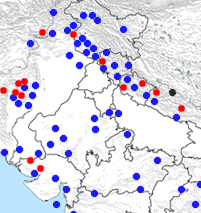|
 Strong
and damaging earthquakes have been felt in all parts of India
and the rest of south Asia. The most seismically active areas are those in
the Himalayan regions of the sub-continent and in the Andaman
and Nicobar Islands due to the peculiar
regional tectonic
setup. The peninsula
area, was generally thought to be "seismically safe". But
recent large quakes such as Koyna &
Killari, have
proven otherwise. Several damaging shocks
have hit this region in historical and ancient times. Strong
and damaging earthquakes have been felt in all parts of India
and the rest of south Asia. The most seismically active areas are those in
the Himalayan regions of the sub-continent and in the Andaman
and Nicobar Islands due to the peculiar
regional tectonic
setup. The peninsula
area, was generally thought to be "seismically safe". But
recent large quakes such as Koyna &
Killari, have
proven otherwise. Several damaging shocks
have hit this region in historical and ancient times.
Notable Earthquakes:
Listing only |
Clickable map
Largest:
South Asia |
Worldwide |
2000 to Present day
|
Notice: Pages in this section (until
1999) are currently offline as they contain unpublished data
and will be made available once they appear in print elsewhere.
Any inconvenience is sincerely regretted. |
Deadliest Earthquakes in South Asia
The M7.6 Kashmir-Kohistan earthquake
in 2005 resulted in the greatest number of fatalities as a
direct result of an earthquake in south Asia in recorded
history. It supersedes the number of fatalities in South Asia
from the M9.1 Sumatra-Andaman earthquake
in 2004. The number of confirmed deaths in south
Asian countries from the 2004 earthquake and tsunami were 41,886 with 11,340 people missing &
presumed dead. The overall figure including Indonesia,
Thailand & East Africa exceeded 2,50,000; the final number
might never be known. These
|
Deadliest since 1900 |
|
Year |
Place |
Deaths |
|
2004 |
Sumatra |
1,80,000+ |
|
2005 |
Kashmir |
~80,000 |
|
1935 |
Quetta |
~35,000 |
|
1905 |
Kangra |
~28,000 |
|
1934 |
Nepal-Bihar |
15,772 |
|
|
are followed by the M7.8 Quetta earthquake
in May 1935 in Balochistan
and the M7.8 Kangra
earthquake in Himachal
Pradesh in April 1905. In
peninsula India, the highest number of
reported casualties
were from the M7.6 Bhuj earthquake
in the state of Gujarat in western India
with 13,805
fatalities in January 2001. All these earthquakes, except the M8.1
Nepal-Bihar earthquake, struck at night or in the early hours
of the morning when most people were indoors in unsafe
buildings. Apart from the 2004 earthquake, in the case of all
others events fatalities occurred as a
direct result of ground shaking. The highest mortality
occurred in the 2004 earthquake on the island of Katchall in
the Nicobar islands, where 86.7% of the population was
confirmed either dead or missing.
In
Quetta with a population between 40,000 and 65,000, the 1935
earthquake killed nearly 26,000 people in the city alone.
Strongest Earthquakes in South Asia
The largest earthquake was recorded in the Andaman & Nicobar
archipelago and adjoining Sumatra in 2004. It had a magnitude of
9.1 (Mw) and was the
3rd largest in the
world since 1900. Tremors were felt over nearly all of peninsula
India, as far as Ahmedabad. The ensuing tsunamis decimated entire
coastal communities in Indonesia, India, Sri Lanka, Thailand and
|
Strongest since 1900 |
|
Year |
Place |
Mw |
|
2004 |
Sumatra |
9.1 |
|
1950 |
Chayu-Arunachal |
8.6 |
|
1934 |
Nepal-Bihar |
8.1 |
|
1945 |
Off Makran Coast |
8.0 |
|
1935 |
Quetta |
7.8 |
|
|
Malaysia and caused
damage and deaths in the Bangladesh, Kenya, Maldives,
Myanmar, Somalia, the Seychelles and Tanzania. The second largest
was an earthquake in Arunachal Pradesh along the Indo-China border
in 1950 also known as the Chayu-Medog
earthquake in Chinese literature. It had a magnitude of 8.6 (Mw) and is the 8th largest
earthquake in the world. Tremors from this earthquake were felt
strongly in Kolkata, near 1,000 kilometres away. The 1945 Makran
earthquake which rocked the coastal areas of the Balochistan and
Sindh provinces in southern Pakistan including the city of
Karachi, was felt as far as Kanpur in Uttar Pradesh. This
earthquake also generated a major tsunami in the Arabian Sea,
which struck Mumbai leaving many dead. In the 1800's, the largest
was the M8.2 Kumaon earthquake in the state of Uttaranchal in 1803
which damaged the Kutub Minar in Delhi and was felt as far as
Kolkata. The greatest historical earthquake in South Asia occurred
on 06 July 1505 and had a magnitude of M~8.2. This long forgotten
earthquake is believed to have originated near the town of Lo
Mustang along the Nepal-China border, the 1505 earthquake resulted
in serious damage in Tibet and also in the Gangetic plains at
Agra, Delhi, Dholpur and Gwalior. In the southern peninsula, the
Kachchh earthquakes of 1819 and 2001 are the strongest with
magnitudes crossing 7.0.
The truth about the infamous 1737
Calcutta Earthquake
Many historical earthquake catalogs for
India list an earthquake in 1737. This event was thought to have
occurred in the Kolkata area and was allegedly responsible for
3,00,000 fatalities making it one of the deadliest quakes
worldwide. However, recent
investigations
clearly prove this claim to be false.
The effects of a severe cyclone which undoubtedly caused damage
and deaths in the Hoogly delta at the same time, are
misinterpreted to have been an earthquake. Other significant
evidence points to an exaggeration in the number of people who
might have been killed by the cyclone, since the population of the
area did not reach the hundred thousand figure until much later in
the 1800's.
|